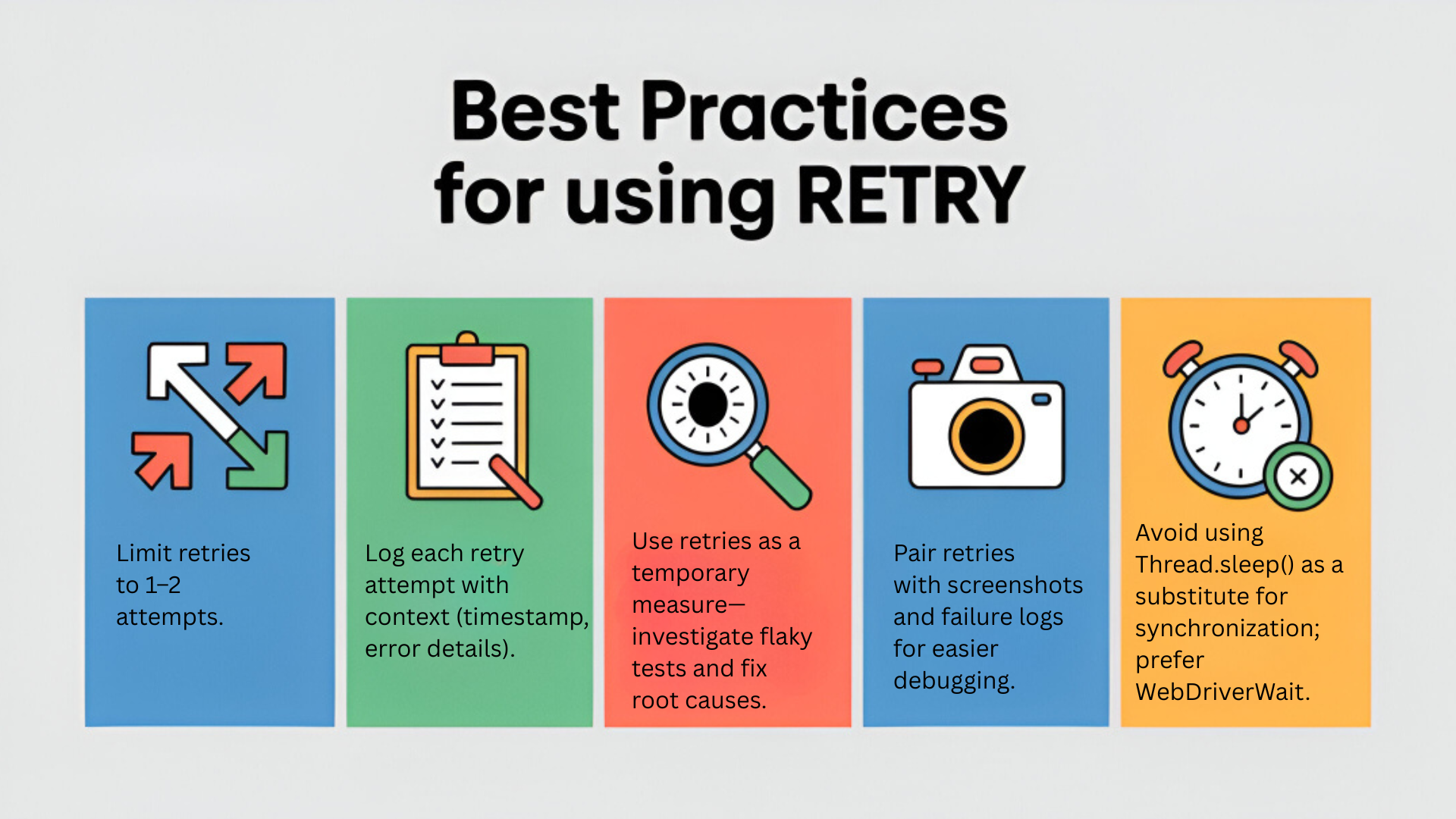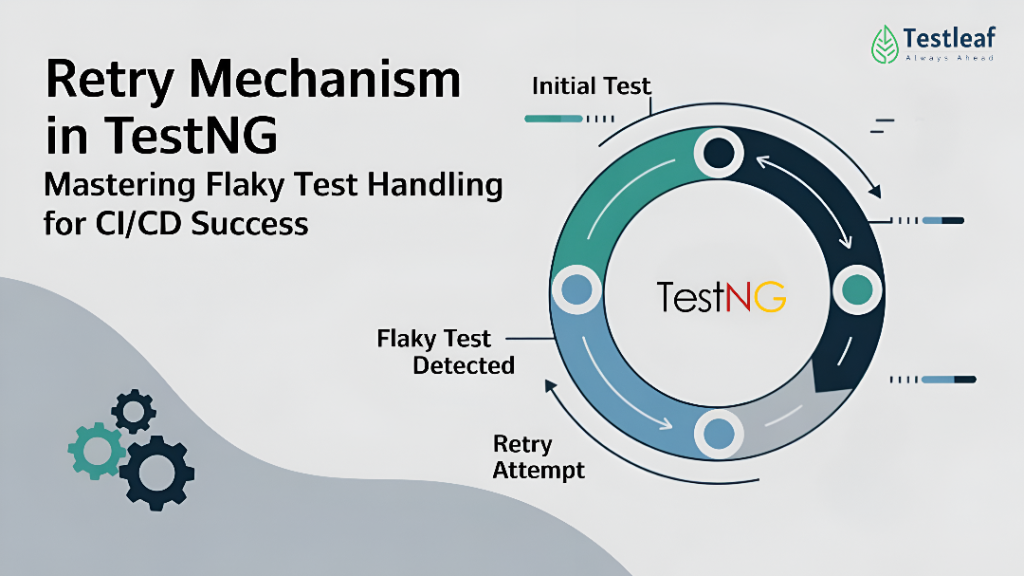Flaky tests are QA’s worst nightmare—wasting time, causing false failures, and slowing releases. TestNG’s retry mechanism offers a smart way to stabilize pipelines.
In the evolving world of automation testing, reliability is not an optional feature—it’s the very foundation of a productive QA pipeline. When tests fail due to inconsistent behavior, slow-loading pages, or intermittent network issues, teams often waste hours rerunning jobs manually or debugging false failures. These issues are commonly referred to as ‘flaky tests.’ If left unaddressed, they erode trust in the automation suite and can slow down delivery cycles.
This is where TestNG’s Retry Mechanism steps in as a powerful ally. Rather than manually re-executing failed tests, you can automatically trigger retries within the same run. In this blog, we will explore TestNG’s retry feature in depth, understand how it works under the hood, integrate it with real-world frameworks, and discuss best practices to use it without masking real issues.
Understanding the Need for Retry Logic
Every automation engineer has encountered the infamous ‘green-then-red-then-green’ syndrome: a test that passes locally, fails in CI, and then passes again on rerun. These inconsistencies can be caused by transient glitches such as network latency, slow server response, or temporary element unavailability. Instead of manually restarting the pipeline, a retry mechanism gives the test another chance before declaring it as failed.
The key benefit here is confidence: your CI/CD pipeline should break only when there is a legitimate bug, not because of flakiness.
Popular Articles: automation testing interview questions
How Retry Works in TestNG
TestNG provides a special interface, IRetryAnalyzer, which acts as a decision-maker for failed tests. When a test fails, TestNG calls the retry() method inside this interface. Based on the logic you define, it decides whether the test should run again. This decision is repeated until the maximum retry count is reached.
Step 1: Creating a Retry Class
Start by creating a simple class that implements IRetryAnalyzer. This class keeps track of how many times a test has been retried and returns true if it should run again.
public class RetryFailedTests implements IRetryAnalyzer {
int count = 0;
int maxRetry = 2;public boolean retry(ITestResult result) {
if (count < maxRetry) {
count++;
return true;
}
return false;
}
}
Step 2: Applying Retry Logic to Test Methods
Once the retry class is ready, attach it to a test using the retryAnalyzer attribute in the @Test annotation. This tells TestNG to use our logic whenever this test fails.
@Test(retryAnalyzer = RetryFailedTests.class)
public void loginTest() {
System.out.println(“Running login test…”);
Assert.assertTrue(false); // Simulating failure
}
Other Helpful Articles: api testing interview questions
Integration with Data Providers
TestNG’s retry mechanism works seamlessly with data-driven testing. If one dataset fails, only that iteration is retried, keeping execution focused and efficient. This is particularly useful when working with login scenarios, form validations, or API calls where multiple input combinations need to be tested.
@Test(dataProvider = “fetchData”, retryAnalyzer = RetryFailedTests.class)
public void createLead(String cname, String fname, String lname) {
// Logic to create a lead
}
Adding Listener Support
While retries solve the execution problem, you also need visibility into which tests passed after a retry. This is where TestNG listeners come into play. You can extend TestListenerAdapter to log retries, capture screenshots, and even feed results into reporting dashboards like Extent Reports.
public class ListenerClass extends TestListenerAdapter {
@Override
public void onTestFailure(ITestResult result) {
System.out.println(“Test Failed: ” + result.getName());
}
}
Best Practices for Using Retry
Retry logic is a double-edged sword: while it improves stability, it can also mask real issues if overused. Here are some recommendations:
✅ Limit retries to 1–2 attempts.
✅ Log each retry attempt with context (timestamp, error details).
✅ Use retries as a temporary measure—investigate flaky tests and fix root causes.
✅ Pair retries with screenshots and failure logs for easier debugging.
✅ Avoid using Thread.sleep() as a substitute for synchronization; prefer WebDriverWait.

Real-World Example in a POM Framework
In a mature automation framework following the Page Object Model (POM), keep the retry logic modular by storing it in a utils or base package. This keeps page classes and business logic clean. Apply retryAnalyzer only at the test level to maintain separation of concerns.
@Test(dataProvider = “fetchData”, retryAnalyzer = RetryFailedTests.class)
public void createLead(String cname, String fname, String lname) {
new LoginPage()
.enterUsername(“DemoSalesManager”)
.enterPassword(“crmsfa”)
.clickLogin()
.clickCRMSFA()
.clickLeads()
.clickCreateLead()
.typeCompanyName(cname)
.typeFirstName(fname)
.typeLastName(lname)
.clickSubmit();
}
CI/CD and Reporting Integration
In CI/CD pipelines, retry logic can be a lifesaver. Instead of failing the entire build due to a transient glitch, the retry allows the build to pass if the issue resolves itself on a rerun. Combine this with tools like Extent Reports or Allure to track which tests passed after retries—this provides actionable insights to improve test stability over time.
Conclusion
Flaky tests are unavoidable in large-scale automation, but they don’t have to slow you down. By implementing TestNG’s retry mechanism thoughtfully, logging retries, and focusing on fixing root causes, you can make your test suite robust and CI/CD friendly.
Think of retries as a safety net: they catch transient failures but should never replace true test stability efforts. The goal is always to minimize retries by improving scripts, waits, and environment stability.
By mastering TestNG retries, QA teams can save hours of debugging time and ship with confidence. Looking to sharpen your skills? Explore advanced Selenium training in chennai and TestNG training programs.
FAQs
Q1. What is the retry mechanism in TestNG?
TestNG’s retry mechanism allows failed tests to rerun automatically using IRetryAnalyzer, reducing false negatives from flaky tests.
Q2. Why is retry logic important in automation testing?
Retry logic ensures CI/CD pipelines only fail for real bugs, not temporary issues like network delays or slow-loading elements.
Q3. How do I implement retry in TestNG?
Create a class implementing IRetryAnalyzer, define maxRetry, and attach it to test methods with retryAnalyzer.
Q4. Can retry logic hide real bugs?
Yes. Overusing retries can mask genuine defects. Limit retries to 1–2 attempts and log each retry for transparency.
Q5. How does retry work with CI/CD pipelines?
In CI/CD, retries prevent entire builds from failing due to transient glitches, making pipelines more stable and reliable.
We Also Provide Training In:
- Advanced Selenium Training
- Playwright Training
- Gen AI Training
- AWS Training
- REST API Training
- Full Stack Training
- Appium Training
- DevOps Training
- JMeter Performance Training
Author’s Bio:

As a Senior SDET with 8+ years in testing and development, I build scalable automation platforms ensuring quality at speed. Passionate about mentoring and innovation, I equip teams with real-time solutions and high-impact frameworks, driving excellence through continuous learning. Let’s shape the future of quality engineering together.
Dilipkumar Rajendran
Senior SDET | Playwright & Selenium Expert








